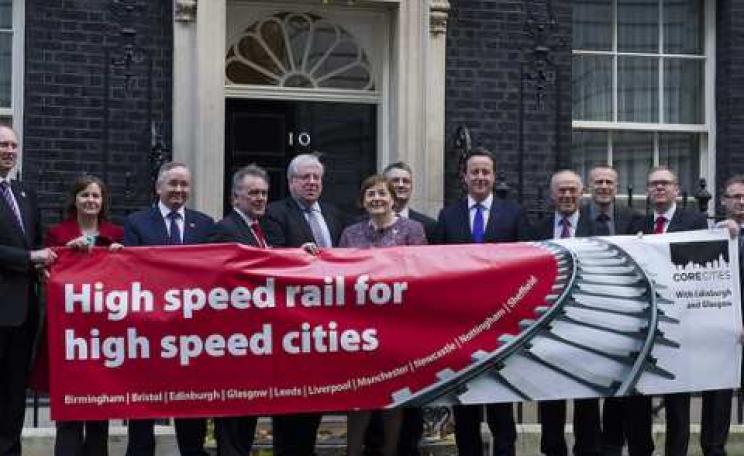Imagine a network where you can get from anywhere to anywhere. Where Heathrow and the Channel Tunnel are connected to every major city, so there's little need for domestic flights. Where massively enhanced capacity allows much lower fares.
Britain doesn't plan infrastructure well.
We cut back on flood control just as global warming makes flooding much more likely.
We privatised railways and energy companies in ways that often do not give consumers value for money.
We built one of the most beautiful, and expensive, bridges in Europe (the Humber bridge) on a politician's whim at the time of a by-election.
We spent £4 billion on the abortive 'Public-Private Partnership' to upgrade the London Underground. We put £1.3 billion into Concorde. And we created a cable-way across the Thames without a plan for long term funding.
Politicians take decisions based on short-term political considerations. Rarely do we take a long-term strategic view. Decisions are not made for many years - and then are rushed. Seldom are the long-term objectives well defined.
Holistic vision - achieving many objectives in an imaginative way - is usually absent. But 'hype' is ever-present. And there is little consideration of who actually benefits from a scheme.
HS2 - the biggest mistake of all?
And now we are about to blunder into one of the biggest mistakes of all time, HS2. The process for this £50 billion-plus scheme has been chaotic and politicised. The government defined a brief that pre-specified the route, without objectively considering alternatives. The stated objectives of the scheme have changed. At different times, the Government has mentioned quicker journeys, increased capacity, and regional development.
Compliance with the Climate Change Act and network connectivity have been almost completely ignored. The scheme is designed as a stand alone line, hardly integrated with the rest of the network. When it was pointed out that HS2 fails to connect the North, the government proposed yet another scheme, HS3, costing perhaps £10 billion. Little has been heard of HS3 since the election.
Land and property owners near stations are the most significant beneficiaries from improved rail. With easier commuting, landlords can charge higher rents. This feeds into higher selling prices. For example, there's a long term program of improvements in the Cambridge-London line. Cambridge has recently seen the biggest increase in house prices outside London.
Imagine a network where you can get from anywhere to anywhere. Where Heathrow and the Channel Tunnel are connected to every major city, so there's little need for domestic flights. Where massively enhanced capacity allows much lower fares.
The upgrades in the Bristol-London line are expected to increase house prices in Bristol by 5-10% above existing trends. But local renters and first time buyers living and working in the town do not benefit. And land and property owners get a huge benefit ... at public expense.
It's the same and worse for HS2. Local people benefit little from ultra-fast service to London and fares will increase too. Smaller cities such as Coventry and Stoke will find they have fewer trains. People across the UK will pay for HS2 in higher taxes, whether they benefit or not. And since the route does not connect many cities - and often goes to isolated parkway stations rather than city centres - the benefits, even for landowners, are small.
A better way - high speed UK
Yet there is a better scheme. There is also a better way to pay for it. Only now has the detail been mapped, costed, and published for discussion and consultation. 'High Speed UK' is an alternative national upgrade plan.
It is based on a four-track spine along the M1 corridor from London to Yorkshire. Its restoration of the abandoned Woodhead corridor between Sheffield and Manchester will relieve trans-Pennine congestion. Liverpool, Manchester, Leeds and Sheffield will be connected together straight away.
Birmingham and the West Midlands will benefit hugely by upgrading key radial routes to four tracks. High speed trains will run on to existing tracks (as in France). This will mean massive time savings on journeys between all the main centres of population in the Midlands and the North of England.
Considering the infrastructure necessary to fully interconnect ten UK primary cities, High Speed UK is estimated to be around £20 billion cheaper than HS2 and HS3 combined - which together still fail to meet the gold standard of full interconnection.
Even a more intensive route which would be necessary to interconnect 33 key centres, offering around 45% average journey time savings, and considering also four-track construction between London and Yorkshire, High Speed UK is still at least £5 billion cheaper than HS2+HS3.
High Speed UK's hugely improved connectivity and capacity will drive the road to rail modal shift necessary to deliver CO2 reductions in line with the 80% reduction target of the 2008 Climate Change Act - whereas HS2 is predicted to be no better than 'carbon neutral'.
A better funding model
High Speed UK could be paid for by levies on property owners who would benefit, an approach which helped to fund the Jubilee line extension. Landowners who benefit from the scheme would pay. Land rents are higher the more connected a location is and the lower the transport costs.
Therefore, the lower the fares, the higher the revenue from land taxes. If land value increases were captured, this makes possible a high capacity, low fare model, rather than the 'high speed for the rich' scheme now in prospect.
Land near stations should be purchased by the government at unimproved values and then developed. This resulting integrated transport and property development near stations could make a large profit for the government. High-capacity rail provides the opportunity to solve the transport and housing crises in an integrated and beneficial way.
The Hong Kong Mass Transit authority makes a profit of $2 billion a year by integrated rail and property development. Railways paid for by these two means (land taxes and property development) could repay the investment to the government many times, giving the public sector a long-term profit.
A vision of the future
It is not too late to get this one right. High Speed UK has been planned in great detail, with 1:25,000 plans of the route and timetables which show exactly who would benefit. The costs of the basic route are £20 billion less than HS2.
The land issues would be much less contentious. The Chiltern Hills would be spared, ancient woodland would be protected and so would the huge cost of tunnelling in the Chilterns and under much of London. Carbon emissions savings would be far greater, giving the UK a real chance of meeting its climate change targets.
Imagine a network where you can get from anywhere to anywhere. Where new and old railway are totally interoperable, so if there's a problem, trains can switch from one line to another. Where Heathrow and the Channel Tunnel are connected to every major city in the country, so there's little need for domestic flights.
Where the North and the Midlands operate as fully integrated and connected 'powerhouses', as soon as possible ... not at some distant point in the future. Where massively enhanced capacity and a better funding model allows much lower fares. Where city centre stations provide the hub for integrated property and rail development, offering convenience for all. All this with a system that could pay for itself - or turn a profit, as Hong Kong has shown.
Rather than degrade existing services, make them better. Rather than merely giving landowners near stations a free ride, ask them to pay for it. And use this as a great opportunity to develop our major cities.
The High Speed 2 hybrid bill is currently finishing its Committee Stage in the House of Commons. After the report stage it will be voted on decisively in its Third Reading in the Commons, before heading to the Lords and then, if successful to Royal Assent.
This is a 'once in two centuries' opportunity. While it's still in consideration in Parliament, it's not too late for a rethink. We cannot as a nation afford to get this one wrong.
Colin Elliff BSc CEng MICE is the designer and Civil Engineering Principal, of High Speed UK. He is a chartered civil engineer UK with over 30 years experience in railway civil engineering.
Andrew Coulson MA PhD is a research fellow at Birmingham University with interests in East Africa, local economic strategies and scrutiny in local authorities. He is Chair of Birmingham Fabian Society.
Stephen Stretton MA MPhil is an economist, financial risk modeller and programmer. He founded Re:think HS2 and is currently writing a commissioned book on tax and welfare reform for a China based British businessman.
Graphics: In addition to those shown here (above right) more images are available from rethink-hs2.uk/graphics.
More on The Ecologist:
- 'Roads to nowhere: why is transport policy getting lost in this election?' by Rupert Read, Sandy Irvine and Bennet Francis.
- 'HS2: Why low speed rail - or closure - is vastly preferable to high speed' by B W Edginton.
- 'HS2: can the UK fast-track a better rail system?' by Bethany Hubbard.
- 'Beyond HS2: invest in existing rail and reduce rail fares to make travel greener' by Richard Hebditch.




